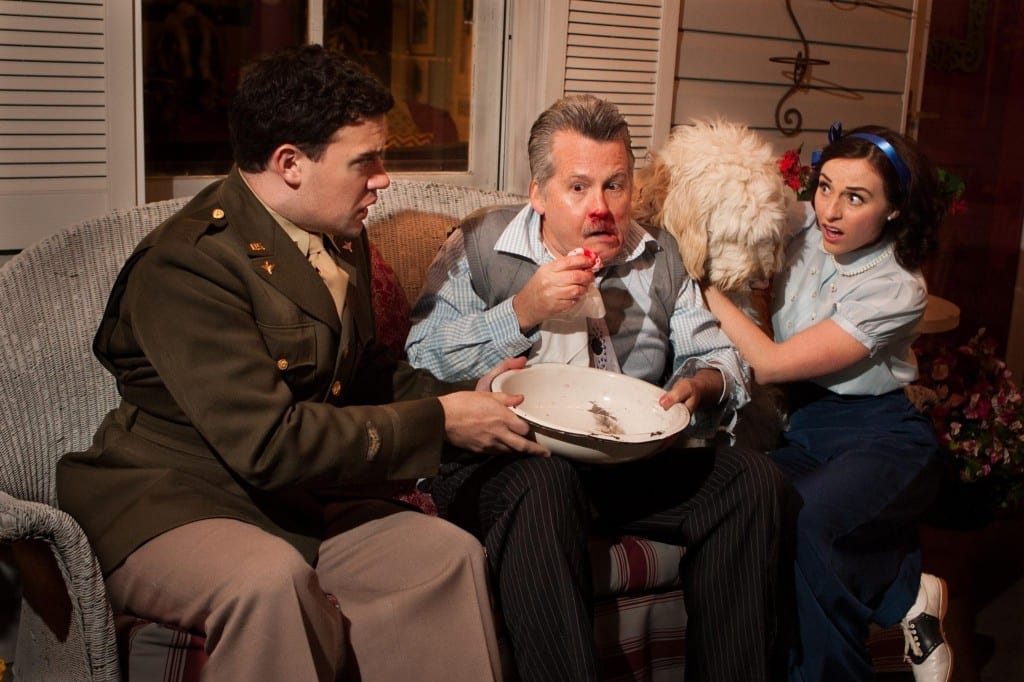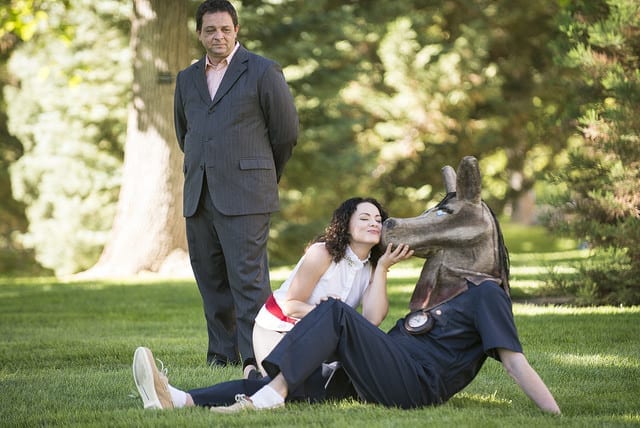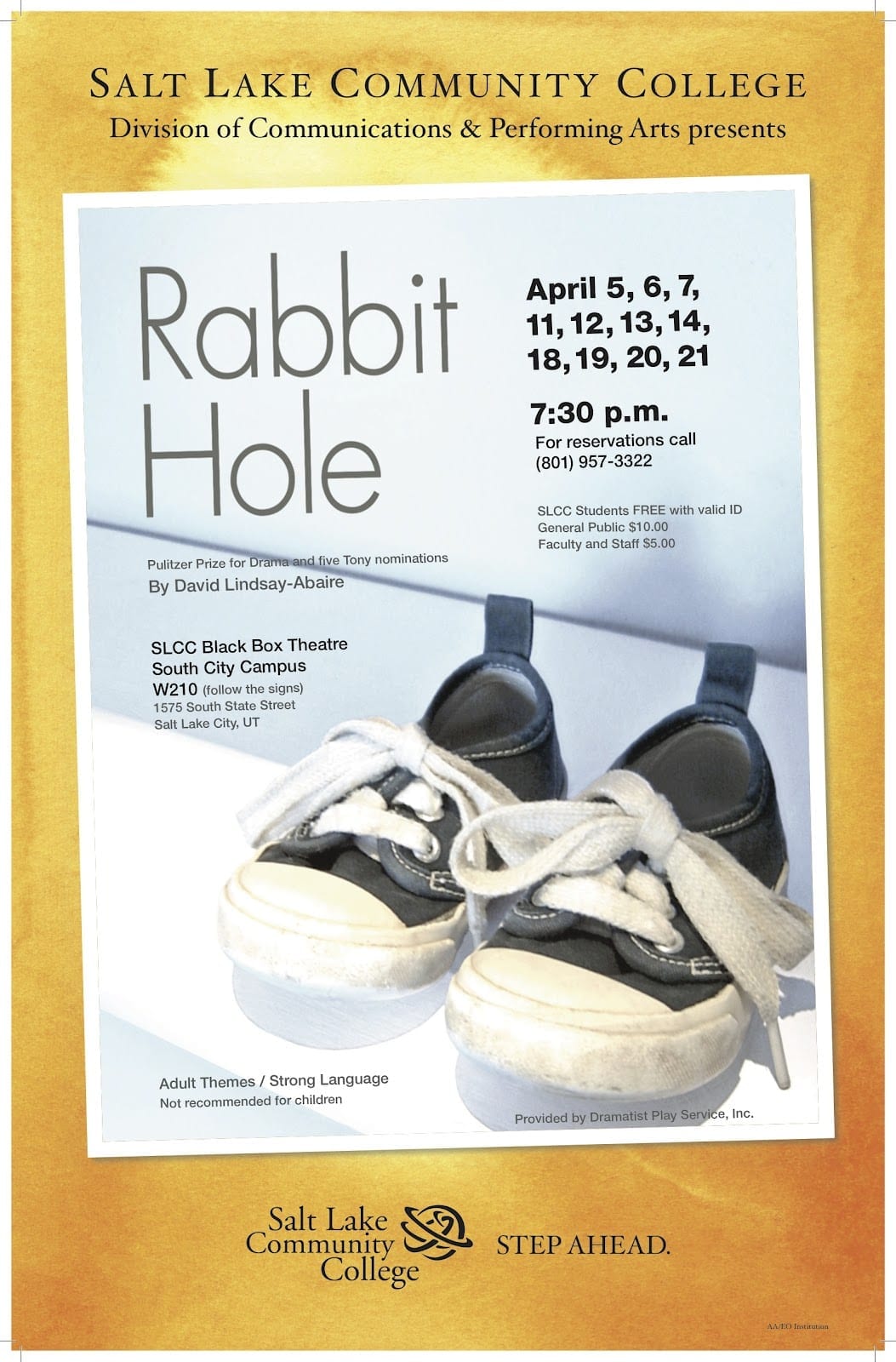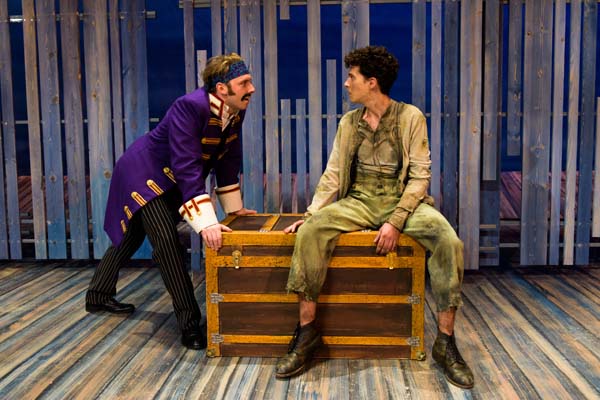OREM — Each time I’ve tried to explain the basic plot of F. Hugh Herbert’s 1943 play Kiss and Tell, I’ve started with the words, “Well, umm…” to buy time before trying to succinctly sum up its plot. That’s because the meaningful aspect of Kiss and Tell isn’t really hidden in the plot. Instead it is found within the relationships between the characters. The backdrop for these relationships is the back porch of an average American family, the Archers, during WWII. While their oldest son is at war, the Archers have created a bit of a battle at home in the form of a feud with the neighbors down the street, the Pringles. This feud is particularly complicated because the daughters of each family, Corliss Archer (Brighton Quinn Hertford) and Mildred Pringle (Allie Rae Saraiva) happen to be best friends. When one of the daughters is spotted entering the obstetrician’s office, the finger-pointing and name-calling really heat up, and the awkward neighbor boy Dexter Franklin (Ammon Loveless) gets caught up in the ensuing mess.
The entire cast of this Hale Center Theater Orem production was incredibly adept at bridging the gap between comedy and drama. In the first scene, each character was introduced through his or her interaction with Mr. Willard (Jack Stokes), who was unassumingly trying to paint a patch of the porch ceiling. Much to Mr. Willard’s dismay, each character had two cents to add to the project. The differing opinions of each character quickly developed into the personalities that would be at odds throughout the production. Saraiva as Mildred presented a spirited but grounded young woman, Pulham as Harry showed an involved but not overbearing father, and Lora Beth Brown showed that the housekeeper Louise was really the person who kept the Archer household going. As each character came and went, a pattern was quickly established that would hold throughout the production: easy laughs casually interspersed between the dialogue that would tell the story. I appreciated a comedy that didn’t try too hard; instead it just captured the things that are funny about family life.
At the center of the plot, the relationships, and ultimately the success of this production was Hertford as Corliss. Her attitude, tone of voice, and body language changed frequently throughout the show to reflect Corliss’s struggle to be seen as a young woman instead of an infant. While interacting with her mother Janet (Shelly Steward Truax), Corliss was demanding and whiny. For her exchanges with her father Harry (Mark Pulham), however, Corliss reserved the tone of young, doting daughter. She kept the brashest tones for frequently yelling at Dexter and adopted grown-up airs when trying to impress the visiting Private Earhart (Casey William Walker). Because Hertford so skillfully delivered a multifaceted Corliss, each of her onstage relationships became unique and important.
 In contrast, Mitch Bandley’s portrayal of Raymond Pringle was beautifully one dimensional. Part messenger, part salesman, and part annoying younger brother, Pringle’s role was often to lessen the onstage tension—which he frequently accomplished through the overuse of two words: “That’s dumb.” Early in the production I felt certain this line would quickly wear thin; however Bandley’s delivery had me chuckling over the same two words right up to the end. I also appreciated Kymberly Luke Mellen‘s direction which was evident in Bandley’s understated “business.” Whether he was snacking on candy or playing with a slinky, Bandley was frequently engaged in believable, repetitious motions over which he delivered his dialogue. As a result, this young actor never appeared fidgety or uncomfortable.
In contrast, Mitch Bandley’s portrayal of Raymond Pringle was beautifully one dimensional. Part messenger, part salesman, and part annoying younger brother, Pringle’s role was often to lessen the onstage tension—which he frequently accomplished through the overuse of two words: “That’s dumb.” Early in the production I felt certain this line would quickly wear thin; however Bandley’s delivery had me chuckling over the same two words right up to the end. I also appreciated Kymberly Luke Mellen‘s direction which was evident in Bandley’s understated “business.” Whether he was snacking on candy or playing with a slinky, Bandley was frequently engaged in believable, repetitious motions over which he delivered his dialogue. As a result, this young actor never appeared fidgety or uncomfortable.
Actually, nothing at all about the production felt uncomfortable or put on. Before the production even started, I was swept into the time period by the two-page spread “WWII by the Numbers” included in the program. Hair and makeup by Janna Larsen and costumes designed by Amanda Fitt placed squarely in the 1940’s what otherwise may have taken place in a vague past era. And Bobby Swenson‘s set designed combined the time period with functionality that allowed the actors to enter, interact, and exit in purposeful ways. Especially effective was the screened half-door which separated yard from porch and allowed for accentuated slamming whenever the scene called for it.
On the whole, Kiss and Tell, was extremely fast-paced, which is not a criticism in any way. I had half-expected a second act lull, but felt none as both comedy and conflict increased steadily throughout. The result of this pace and the argumentative dialogue, however, created a very noisy show. As is probably the case in the daily dialogues within many homes, it seemed someone was always talking, and more often than not, someone was always yelling. Thanks to Cody Hale‘s sound design, the actual noise level was never too high. And thanks to Truax as Janet Archer, I particularly enjoyed a beautifully quiet moment. As the plot took each of the other actors off the stage and left Truax alone, I felt momentarily caught up in her emotions as Corliss’s mother, her life taking an unexpected and unstoppable turn. Without words, she expressed loss, bewilderment, and hopelessness all laced unmistakably with love. If any one moment summed up the idea of Kiss and Tell, this was it.
Mellen wrote in the program’s notes that she hoped the audience would be able to relate to the conflicts of the production. To “gossip and little lies blown out of proportion,” to “the knee-jerk reaction to defend those we love,” or “to children wanting to grow up too quickly.” In presenting a relateable story, this production was certainly successful. In providing an evening of laughs, it certainly delivered. And in providing an insight into what so often underlies life’s conflicts, Kiss and Tell caught the essence of something as intangible as love. Grab a group of friends, take a date, or enjoy an evening out with the whole family. There’s enough heart in this production to go around.







